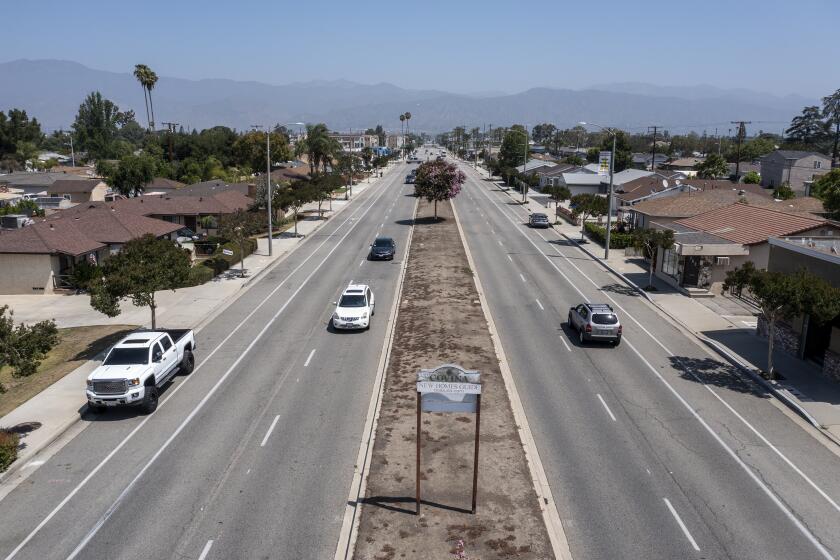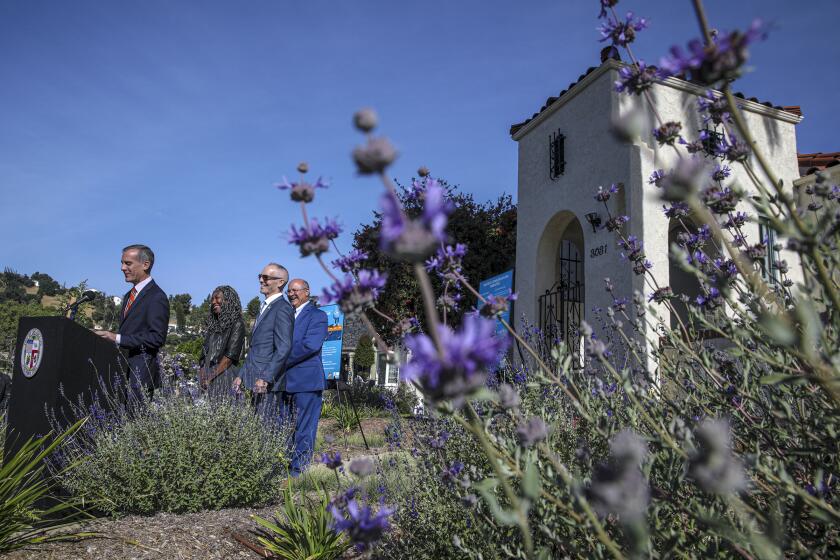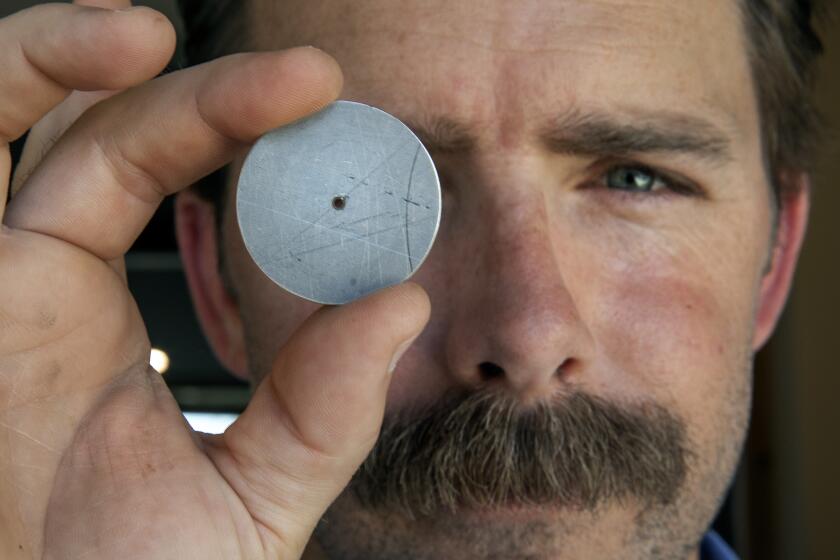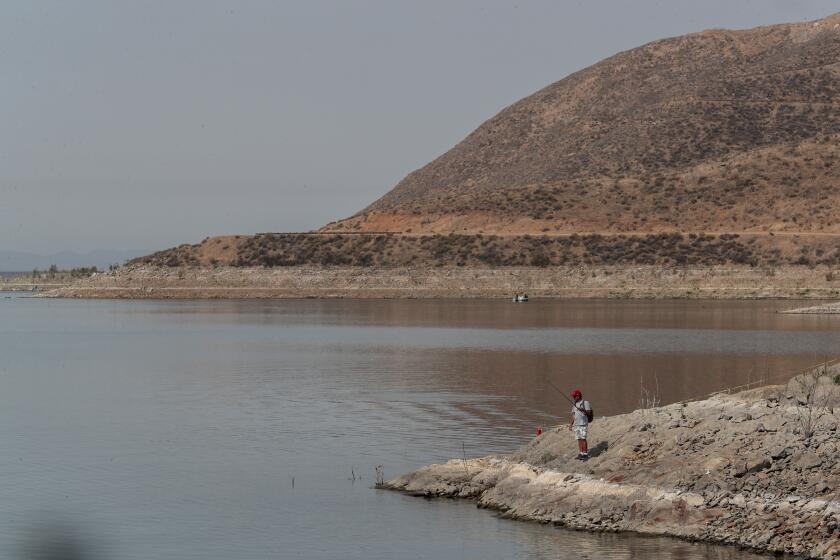Early signs indicate Southern California finally using less water. But big test lies ahead

- Share via
Less than a month after sweeping water restrictions took effect across Southern California, early indications suggest residents are finally heeding calls to conserve as officials report a noticeable drop in demand throughout the region.
Officials at the Metropolitan Water District of Southern California reported that demand was 5% lower than what they hoped to see under the first three weeks of restrictions.
At the same time, water waste complaints have soared throughout Los Angeles, signaling perhaps that many residents have taken conservation to heart.
Although the initial indications were encouraging, officials stressed that the savings must continue as regional reservoirs continue to dip toward perilous lows. They also stressed it is still too soon to tell whether residents have truly turned a corner after months of backsliding.
“We must continue to conserve,” Joaquin Esquivel, chairman of the State Water Resources Control Board, said during a board meeting this week. “We have a long way to go. It is still a long summer that we have before us and a lot of work.”
More than 6 million Southern Californians will be placed under new drought rules today in an unprecedented effort to conserve water.
Under the new rules, which went into effect June 1, Southern California water agencies were ordered to reduce their use of State Water Project supplies by 35% due to a water shortage emergency. The State Water Project is a complex system of reservoirs, canals and dams that functions as a major component of California’s water system, feeding 29 agencies that together provide water for about 27 million residents.
So far, the affected agencies appear to be staying within their budget, according to a report from the MWD, the regional wholesaler that ordered the cuts.
“It’s very early, and we’re just out of the starting blocks,” said Brad Coffey, the district’s manager of water resources. “What’s clear is that the agencies are taking actions to use less water than what we would have expected otherwise, so in that regard, this emergency water conservation program is showing early signs of success.”
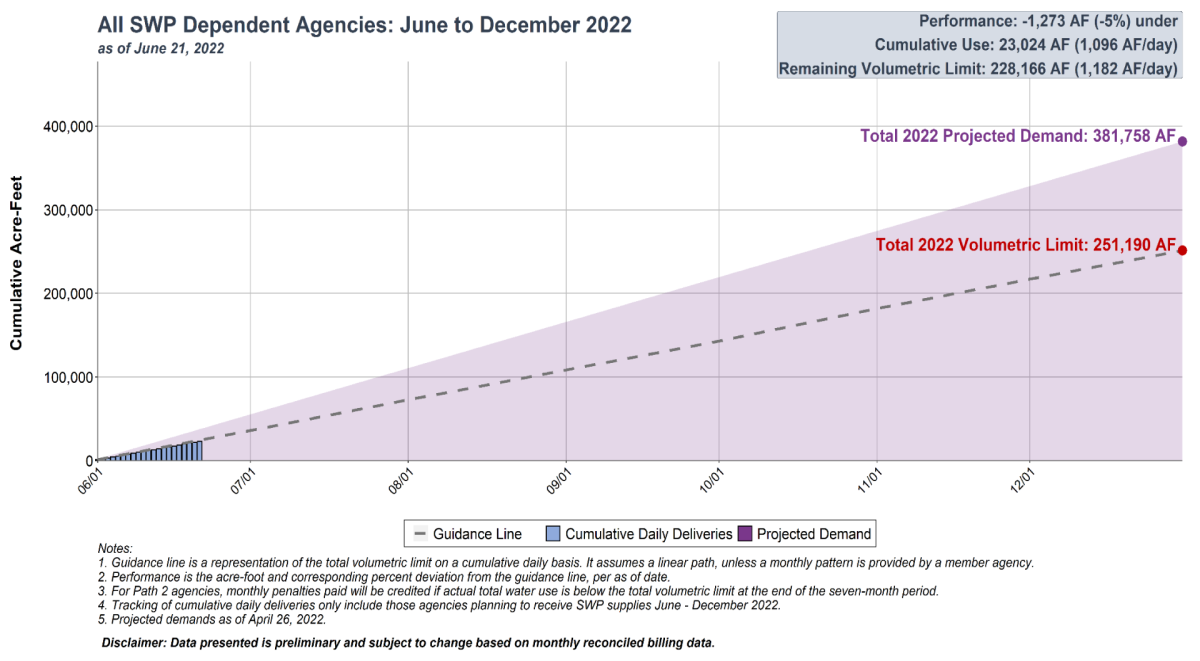
The affected water agencies had initially projected the need for about 380,000 acre-feet of State Water Project water from June to December, but the MWD has only about 250,000 acre-feet to give. (An acre-foot is enough water to supply two to three families for a year, and would fill an Olympic-sized pool halfway.)
According to the latest figures, the agencies are so far keeping pace, using about 5% less than the volumetric limit in aggregate — or 1,273 acre-feet. To get there, some implemented one-day-a-week outdoor watering restrictions, while the others opted to stay below a specified amount.
The report does not provide a breakdown of demand by individual water agencies, and some, including the Los Angeles Department of Water and Power, said it’s too early to give an official update. Others were cautiously optimistic.
“Overall, as a region, progress is headed in the right direction,” said Dan Drugan, spokesman for the Calleguas Municipal Water District, one of the agencies affected by the rules.
“In southeast Ventura County, we need to step up our conservation efforts so that this trend continues for the region. It is still early. There remains a real possibility that our communities may have to move to a ‘no outdoor water use’ mandate in the fall if conservation goals are not achieved this summer,” he said.
The Inland Empire Utility Agency said it has benefited from investments in local supplies, which have enabled it to reduce its demand on imported water 35% below the targeted reduction.
“However, the time is now to continue to step up our efforts of preserving water supplies as we enter summer and as we prepare for next year as well,” deputy general manager Christiana Daisy said.
As California drought worsens, the DWP in Los Angeles will limit outdoor watering to two days a week, with watering capped at eight minutes per station.
David Pedersen, general manager of the Las Virgenes Municipal Water District in western Los Angeles County, similarly said that things are “starting off on the right foot,” but there’s still a long road ahead.
“We have three weeks of data that we’re looking at, and June is not the hottest part of the summer,” he said. “It’s going to get harder as we get into July, August and September, so even though we’re tracking well, it’s way too early to get excited.”
Pedersen said Las Virgenes had to implement one of the region’s most stringent plans to meet the reduction, in part because the agency is heavily reliant on state water and in part because its customers have historically had high daily usage.
A 73% reduction will be required to get to the desired 80 gallons per person per day, he said, and so far, residents have done an “enormous job” and reduced demand by about 50%.
And though some neighborhoods in the Las Virgenes service area — including Calabasas and Hidden Hills — came under scrutiny during the previous drought for their excessive water use, officials this time around are working to prevent a repeat performance by installing flow restriction devices on customers who refuse to abide by their new one-day-a-week watering rules.
They’ve installed about 20 such devices so far, Pedersen said, but the concept is less about punishment and more about spreading awareness, which seems to be working.
“I do see some really exciting change happening, and that’s one of them ... customers really, truly taking more ownership, more agency, in their water usage,” he said.
In one wealthy Los Angeles County enclave, 70% of water is used outdoors. Officials hope to curb chronic overuse with these custom flow restrictors.
There are other indications that residents are heeding the call.
Angelenos filed 1,198 reports of water waste to the Los Angeles Department of Water and Power in May, significantly more than during the same month last year, when 544 such reports were made, according to the agency. There were 672 reports in the first two weeks of June.
“We are very encouraged by the increase in water waste complaints we have received — it shows people are taking the drought seriously and trying to cut back their use as well as reporting on potential violations of the ordinance,” DWP spokeswoman Ellen Cheng said.
Some of the common complaints are water running off of lawns and into the street because of excessive irrigation or people watering on the wrong days, she said. Under the new city rules, residents with even-numbered addresses can water on Sundays and Thursdays, while odd-numbered addresses can water on Mondays and Fridays.
The DWP’s conservation response unit team is patrolling each day and following up on waste reports they receive, Cheng said.
“They are focused on educating our customers on the new ordinance but are also prepared to take stronger action with citations if the written warnings are ignored,” she said.
About 314 of the water waste reports in May were made through My LA 311, city data show. Residents in Mid-Wilshire were by far the biggest complainers of that set, filing 86 reports to the service, while Brentwood was second with 53.
The South Coast hydrologic region, which includes Los Angeles, used 25.6% more water this April than in April 2020
Residents are also showing progress statewide.
Preliminary figures released by the water board this week showed urban water use decreased by 5% in May compared with the same month in 2020, the baseline year against which current savings are measured.
The data are based on early reporting by many of the state’s water districts, which have started turning in figures sooner in response to requests by Gov. Gavin Newsom and state regulators. If the number holds, it will be a marked improvement from April, when statewide water use increased nearly 18%.
But there is still more work to do. Last July, Newsom called on Californians to voluntary save 15%. The cumulative savings through May, according to the preliminary figures, are just 3%.
“It looks like some of the conservation and drought messaging is getting through — that people are making adjustments — but we do need people to continue to conserve water,” James Nachbaur, a director of the water board, said Tuesday.
Coffey, of the MWD, said he didn’t want the positive trend to imply that anyone can declare victory.
“We recognize that there’s a momentum that’s needed, so we’re trying to kind of get the car up to freeway speeds,” he said. “We’re not wanting to suggest that people could step off the gas yet when they’re on the freeway onramp.”
Times staff writer Ian James contributed to this report.
